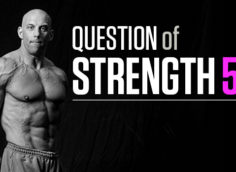This protocol, which divides the body into the left side and right side within a workout, can contribute to power development, strength development, muscle development, and fat burning.
This looks simple on paper, but trust me, five exercises for 6 reps on one side of the body followed by five exercises for 6 reps for the other side is challenging.
Here's an example of a "Power of 6" training sequence targeted towards developing power:
- One-Arm Dumbbell Snatch from Hang – 2-4 sets x 6 reps
- One-Arm Dumbbell Flat Bench Press – 2-4 sets x 6 reps
- One-Arm Dumbbell Sumo Deadlift (from floor) – 2-4 sets x 6 reps
- One-Arm Standing Dumbbell Row – 2-4 sets x 6 reps
- One-Arm Overhead Dumbbell Push Press with Staggered Stance – 2-4 sets x 6 reps
Perform all the exercises without rest for one side of the body (weak side first). Then immediately proceed to the other side and work through all the exercises again. Both sides completed (left and right) equals one set.
Rest after completion of both sides. Rest as long as you need between each set in order to perform the next full left/right set with equal load and intensity.
Here's what it looks like. (Note: The video below includes an optional sixth movement – a one-arm lockout plank hold. I'll explain that in a bit.)
Aaron Chigol, Natural Masters Bodybuilding Champion
This is a "load-centric" kinetic-chain expression sequence. The reason you see 6 reps of each exercise is because the load you select should be heavy enough to challenge you for these lower reps, but you don't want to work to failure on any exercise in the sequence. This is what's called training within the "range of success."
It's also advisable to use lifting straps. You don't want to worry about your grip as you go through the sequence. Be sure not to hurry from one exercise to the next. Execute the five exercises for 6 reps in a pace you can sustain.
- One-Arm Dumbbell Snatch from Hang: Execute with speed. This movement is powered from the ground and driven through the core. Go from the hang position to full lockout overhead in one fluid motion. Perform as one-rep singles repeated 6 times. In other words, you pause momentarily between each rep.
- One-Arm Dumbbell Flat Bench Press: This may feel weird to those who've never done them before. You'll feel this difference in areas you wouldn't suspect, like all through your anterior obliques. You can do this movement from the normal flat bench or from a stability ball, which will provide far less stabilization.
- One-Arm Dumbbell Sumo Deadlift: With the dumbbell positioned on the floor horizontally between your legs, perform 6 fluid reps, making sure to touch the floor between each rep. Don't bounce!
- One-Arm Standing Dumbbell Row: Perform 6 standard heavy one-arm dumbbell rows using smooth reps.
- One-Arm Overhead Dumbbell Push Press with Staggered Stance: The reason you want to use a staggered stance is that it will disperse the load over the lower lumbar area. This means less load on the lower paraspinals, which have been involved in each of the previous exercises.
This stance also results in less spinal compression forces, which negates injury risk and allows you to focus more on the load you're lifting. Once again, emphasize a heavy but fluid 6 reps.
Application is everything with hybrid workouts and/or metabolic sequences like this. When the goal is muscle development, I prefer to add these types of complexes at the end of specific body-part workouts, perhaps replacing ab work or cardio.
However, this complex can also be done for a greater number of sets as a separate workout, on a separate training day all its own.
If you're using this complex as a metabolic finisher after a body-part training day – preferably after arm workouts or delt workouts because they're less metabolically demanding – then two sets should be enough. And no need to use this complex more than once per week. With a finisher like this, you're better off under-using it than overusing it.
If you're using this complex as its own separate workout, then it should be used on a day that immediately precedes a day off. You can also up the sets, doing up to four sets and then finishing with maybe a superset or a complex that includes biceps/triceps or even light abs for a three or four exercise complex.
If you want to do this workout on its own, you can totally Frankenstein this monster. For instance, try adding a sixth exercise – a one-arm lockout plank hold for a slow count of 20.

Place the hand of the side you're working on the floor and either point the free arm completely forward or place it on your hip. The one-arm lockout plank hold is basically the lock out position of the push-up, but with only one arm on the floor. Spread your feet wide to broaden your base of support. Hold for a slow count of 20.





